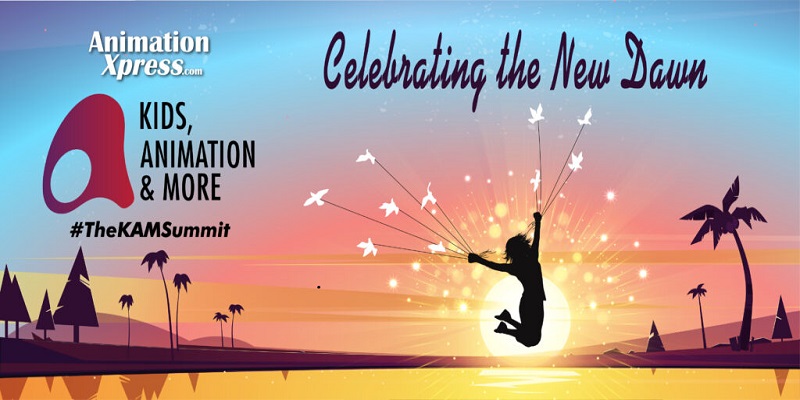
KAM Summit 2022 was a witness to multiple interesting panel discussions and one of them included a discussion on getting kids’ attention in a fragmented universe and representatives from the animation industry shared their opinions. With the attention span of kids reducing, this session explored the various tools that creators are using to keep the young ones hooked. The speakers of the session were: Gubbare AVP content and strategy Brian D’costa, Warner Bros. Discovery head of kids cluster – South Asia Uttam Pal Singh, YoBoHo New Media founder and CEO Hitendra Merchant, ETV Bal Bharat head of channel operations and international licensing acquisitions Shashi Prakash Singh, and Grafiti Multimedia founder, FICCI AVGC Forum co-chairman, and MESC advisory board member Munjal B. Shroff. The session was moderated by Punnaryug Artvision founder and FICCI AVGC Forum chairman Ashish Kulkarni.
Kulkarni initiated the discussion by rightly saying that the kids genre is the most loved category in the ecosystem of television and also the most loyal. “When it comes to watching content, kids are the only ones who come day after day, hour after hour to watch their heroes and characters over and over again. They learn from them and discuss their favourite characters with parents and friends.” He quickly threw a few questions to the panel, which kept the audiences curious to know the broadcasters and creators’ take.
Keeping the kids glued to the screens is quite a task, but the pandemic has seen a lot of growth in viewership for kids. Speaking from personal experience, D’costa said, “During the pandemic, since the kids couldn’t go out, they were glued to a lot of screen time, both for education and entertainment. There has been an upside in the revenue as well in the last two years. We have got lots of advertisers on board. We’ve grown 20-25 per cent from the 2018-19 trend, and we saw an increase of nine per cent which has now come down to seven per cent since everything has opened up.”
Tapping on what time is best-suited for the young ones and what is their favoured kind of content is extremely important. Knowing exactly what the kids want is half the battle won. Pal Singh observed, “On weekends, kids watch TV more than on weekdays, since it’s their holiday. They will switch on the TV sets early in the morning at 7.30 and probably watch it throughout the day. During the pandemic, all days were weekends for them. That was their biggest joy in life. Right from the morning till the night, we could see constant engagement and unprecedented viewership growing. But, we were only packed with limited ammunition. We saw repeats after repeats and we couldn’t provide them with new content. When the same episodes saw a decline in viewership, that’s when the broadcasters realised they needed to add more fuel.”
Good planning is imperative for grabbing viewership, especially when it comes to the pre-teen age group. They are in their attention-deficit phase and keep wandering from one platform to the another to finally be able to sit with one show. Prakash Singh explained, “How is a kid watching TV, at what time, in which mood, and with whom – is what we as broadcasters try to understand. All quadrants need to fall in place to create excellent content. For example, between 12-1.30 pm, the digital and TV viewership goes up since during that time, the kid is alone mostly. These factors helped us analyse and we brainstorm further to take it forward.”
The pandemic also gave birth to tons of new and offbeat options for the kids to explore. Since animation as a medium does not require you to go out and shoot, the animators were sitting at home and making content and as a result, there was a rise of mediums apart from the traditional TV. Shroff pointed out, “The fact remains that kids love to consume content and definitely want more of the characters they love to watch. The pandemic gave them the opportunity to engage more. One definite shift that has happened with content discovery, even for kids, is that consumption moved just from TV to OTT and apps as well. Because content was being repeated, the kids started seeking other platforms to discover new content, for example YouTube.”
While Prakash Singh emphasised on the importance of bringing content in regional languages to the kids, Merchant stressed on the fact that if the quality of content is superior, the characters are fun, and the little ones resonate with them and find it engaging enough, there is no stopping for the viewership to grow manifold. The panellists also highlighted that as creators, their moral responsibility is to impart overall social and life skills development to the little ones. Irrespective of targeting a gender, the motive is to take Indian traditions and culture forward; thereby serving as both educational and entertaining content.
Whether it is the good-old 30-minute program format, the new 11-minute trend that most shows are following, or a one hour omnibus with multiple short stories; well-made content doesn’t come with rules and irrespective of the duration, if it clicks with the young audiences, it will be watched repeatedly. There is no one formula, but the trick is to always keep evolving, adapting, and experimenting.
Animated content is expanding globally. Feature animation and original TV series are increasing exponentially. This boom, of course, is primarily being driven by streaming services and the rise of OTT platforms. Audiences are hungry for native language, high-end content, and streamers are beginning to target a new, younger audience. The little ones and their demands are no longer being overlooked. Times are changing, and fast. And, as Pal Singh expounded, “Yes, there are some hurdles, but the kids genre is flourishing and thriving.”
